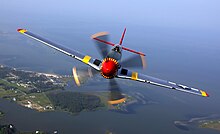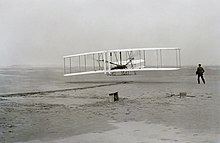
Back Къухьлъат ADY Vliegtuig Afrikaans አውሮፕላን Amharic Avión AN طائرة Arabic ܛܝܣܬܐ ARC ايركرافت ARZ উৰাজাহাজ Assamese Avión AST Awyuna Aymara


| Airplane | |
|---|---|
 The first flight of an airplane, the Wright Flyer on 17 December 1903 | |
| Classification | Vehicle |
| Industry | Various |
| Application | Transportation |
| Fuel source | Petrol, electricity, diesel, natural gas, hydrogen, solar |
| Powered | Yes |
| Self-propelled | Yes |
| Inventor | Wright Brothers |
| Invented | 1903 |
An airplane (American English) or aeroplane (Commonwealth English), informally plane, is a fixed-wing aircraft that is propelled forward by thrust from a jet engine, propeller, or rocket engine. Airplanes come in a variety of sizes, shapes, and wing configurations. The broad spectrum of uses for airplanes includes recreation, transportation of goods and people, military, and research. Worldwide, commercial aviation transports more than four billion passengers annually on airliners[1] and transports more than 200 billion tonne-kilometers[2] of cargo annually, which is less than 1% of the world's cargo movement.[3] Most airplanes are flown by a pilot on board the aircraft, but some are designed to be remotely or computer-controlled such as drones.
The Wright brothers invented and flew the first airplane in 1903, recognized as "the first sustained and controlled heavier-than-air powered flight".[4] They built on the works of George Cayley dating from 1799, when he set forth the concept of the modern airplane (and later built and flew models and successful passenger-carrying gliders)[5] and the work of German pioneer of human aviation Otto Lilienthal, who, between 1867 and 1896, also studied heavier-than-air flight. Lilienthal's flight attempts in 1891 are seen as the beginning of human flight.[6] Following its limited use in World War I, aircraft technology continued to develop. Airplanes had a presence in all the major battles of World War II. The first jet aircraft was the German Heinkel He 178 in 1939. The first jet airliner, the de Havilland Comet, was introduced in 1952. The Boeing 707, the first widely successful commercial jet, was in commercial service for more than 50 years, from 1958 to at least 2013.
- ^ "Global air traffic hits new record". Channel News Asia. 18 January 2018. Archived from the original on 3 January 2021. Retrieved 28 May 2022.
- ^ Measured in RTKs—an RTK is one tonne of revenue freight carried one kilometer.
- ^ Crabtree, Tom; Hoang, Tom; Tom, Russell (2016). "World Air Cargo Forecast: 2016–2017" (PDF). Boeing Aircraft. Retrieved 12 May 2018.
- ^ FAI News: 100 Years Ago, the Dream of Icarus Became Reality Archived January 13, 2011, at the Wayback Machine posted 17 December 2003. Retrieved: 5 January 2007.
- ^ "Cayley, Sir George: Encyclopædia Britannica 2007". Encyclopædia Britannica Online, 25 August 2007.
- ^ Otto-Lilienthal-Museum. "Otto-Lilienthal-Museum Anklam". Lilienthal-museum.de. Retrieved 4 March 2022.
© MMXXIII Rich X Search. We shall prevail. All rights reserved. Rich X Search